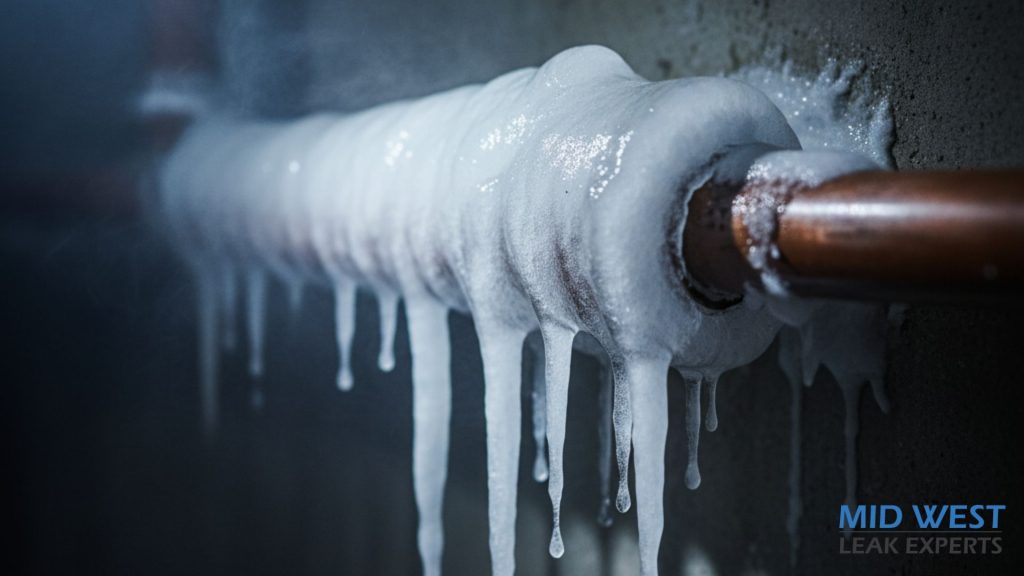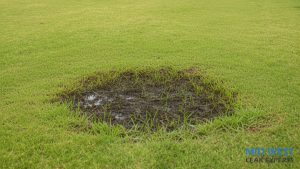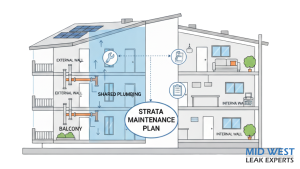Have Frozen Pipes? Read This
The thought of a frozen pipe is enough to worry any homeowner in Central West NSW. During the cold snaps in Orange, Bathurst, and Lithgow, the question often arises: do frozen pipes always burst? The simple answer is no, but the risk is incredibly high and the consequences can be devastating.
When water freezes, it expands by about 9%. While this expansion puts some stress on the pipe, it is not the primary cause of a burst. The real danger comes from the immense water pressure that builds up between the ice blockage and a closed tap. Understanding what happens when pipes freeze is the first step in protecting your property.
A frozen pipe that does not burst can still cause significant problems, including hidden leaks that waste water and cause slow, unseen damage. This is why professional assessment and intervention are crucial. At Mid West Leak Experts, we specialise in identifying and resolving these high-pressure situations before they lead to a catastrophe.
What Happens When Pipes Freeze Inside Your Walls?
The process of a pipe bursting from freezing is often misunderstood. It is a powerful demonstration of physics happening right inside your walls, floors, or ceilings. When temperatures plummet, the water inside a pipe begins to freeze. An ice blockage, or plug, forms. This plug prevents water from flowing through the pipe.
However, the water supply is still pushing water towards this blockage. This is where the extreme danger lies. The trapped water has nowhere to go. As more water pushes against the ice plug, the pressure builds to an astronomical level. This pressure can easily exceed what the pipe, whether it is copper, steel, or plastic, was designed to handle. Eventually, the pipe fails at its weakest point, resulting in a sudden and destructive burst that releases a huge volume of water into your home or business.
The Science Behind The Pressure Buildup
To understand why frozen pipes burst, you need to think about pressure. Water itself is nearly incompressible. When it gets trapped between the ice plug and a closed fixture like a tap, the pressure from the mains water supply continues to build. This pressure can quickly rise to thousands of pounds per square inch (PSI).
A typical residential plumbing system operates at around 40-80 PSI. The pressure created by a freeze can be many times that amount. The pipe itself becomes a pressure vessel it was never intended to be. The burst does not always happen where the ice is located. It often occurs somewhere between the ice blockage and the tap, where the liquid water pressure is at its peak. This is why even a small section of frozen pipe can cause a major failure metres away.

Why Some Pipes Survive And Others Do Not
Several factors determine whether a frozen pipe will burst. The material of the pipe plays a significant role. More flexible pipes like PEX have a greater ability to expand under pressure compared to rigid copper or galvanised steel pipes, giving them a slightly better chance of survival.
The age and condition of the plumbing are also critical. Older pipes with corrosion or weak joints are far more likely to fail. The duration and intensity of the freeze are also key. A quick, light freeze might not create a solid enough ice plug to cause a burst. However, a prolonged deep freeze, common in the higher altitudes of the Central West, dramatically increases the frozen pipe risk by allowing a very solid blockage to form and pressure to build to its maximum potential.
Understanding The Real Frozen Pipe Risk For Your Property
The risk associated with a frozen pipe extends far beyond the immediate inconvenience of having no water. A burst pipe can unleash hundreds of litres of water per hour, causing extensive and expensive damage to your property. The aftermath of a burst pipe is often a complex and stressful situation involving water extraction, structural repairs, and mould remediation.
For businesses in Parkes or Forbes, a burst pipe can mean costly downtime, damaged stock, and loss of revenue. For homeowners, it means damage to cherished possessions and major disruption to daily life. Recognising the full scope of the frozen pipe risk is essential for taking the necessary preventative measures to protect your investment and ensure peace of mind during the winter months.
The Catastrophic Damage A Burst Pipe Can Cause
When a pipe bursts, the damage is swift and severe. Water can saturate plasterboard walls, warp timber floors, and ruin carpets within minutes. It can seep into electrical systems, creating a serious fire hazard.
Ceilings can collapse under the weight of the water, and structural components of the building can be compromised. Beyond the initial water damage, the lingering moisture creates the perfect environment for mould and mildew to grow. Mould can cause serious health problems and requires specialised, costly remediation to remove completely. The repair bill for a major burst pipe can easily run into tens of thousands of dollars, making prevention an incredibly wise investment.
Hidden Leaks From A Minor Freeze
Not every frozen pipe results in a dramatic, gushing burst. Sometimes, the immense pressure only creates a tiny pinhole leak or weakens a joint. These small leaks are far more insidious. They can drip slowly for weeks or months inside a wall cavity or under a floor without any obvious signs.
By the time you notice a damp spot or a musty smell, significant structural damage and mould growth may have already occurred. These hidden leaks also lead to surprisingly high water bills. At Mid West Leak Experts, we use advanced non-invasive technology like acoustic sensors to detect the faint sound of these hidden drips, allowing us to pinpoint the problem without destructive guesswork and save you from long-term damage.
The Financial Impact On Homeowners And Businesses
The financial fallout from a burst pipe can be substantial. There is the cost of the emergency plumbing repair itself, which can be significant, especially if it occurs after hours. Then there are the costs of repairing the water damage, which can include replacing flooring, walls, insulation, and furniture.
While insurance may cover some of these costs, policies often have excesses, and making a claim can be a lengthy and stressful process. For guidance, the Insurance Council of Australia provides resources to help you navigate claims for water damage. For commercial properties in Mudgee or Cowra, the financial impact is compounded by business interruption. Lost productivity, damaged equipment, and potential closure during repairs all add to the final bill. Preventing burst pipes is one of the most effective ways to protect your financial well-being.
Why Do Frozen Pipes Burst More Often In Certain Areas?
The location of a pipe within your property is the single most important factor in determining its vulnerability to freezing. Pipes that are exposed to cold air without adequate protection are at the highest risk. This is why understanding your home’s or building’s layout is crucial for preventing burst pipes.
Certain areas consistently lack the insulation or warmth needed to keep the water inside them from reaching freezing point during a cold Central West winter night. Identifying these high-risk zones allows you to focus your prevention efforts where they will be most effective. The most common problem spots include:
- Pipes located in uninsulated or poorly insulated exterior walls.
- Water supply lines in unheated areas like attics, crawl spaces, and basements.
- Pipes in garages, especially those running along outside walls.
- Outdoor hose bibs, garden taps, and irrigation lines that have not been properly drained.
- Any plumbing that is exposed to severe cold drafts, such as near vents or cracks in the foundation.

Proactive Steps For Preventing Burst Pipes This Winter
Prevention is always better than a cure, especially when it comes to frozen pipes. Taking proactive steps before the first frost is the most effective way to mitigate your risk. Many preventative measures are simple and inexpensive, yet they can save you thousands of dollars in potential repairs.
A small investment in time and materials can provide robust protection for your plumbing system throughout the coldest months. By making winterisation a regular part of your property maintenance routine, you can face the winter with confidence. For comprehensive guidance, you can also review official advice from the NSW SES on preparing your property for severe weather events.
Simple Insulation Techniques You Can Do Yourself
Insulating vulnerable pipes is your first line of defence. You can purchase foam pipe sleeves or fibreglass insulation wrap from any hardware store. These materials are easy to install and create a thermal barrier that slows down heat loss from the pipe. Focus on pipes in unheated areas like your garage, attic, or under the house. Use tape or cable ties to secure the insulation snugly around the pipes, ensuring there are no gaps. Additionally, look for any air leaks near your pipes, such as cracks in the walls or foundation. Sealing these gaps with caulk or spray foam will prevent cold air from blowing directly onto your plumbing.
Managing Your Water System During A Cold Snap
During periods of extreme cold, a few simple actions can make a big difference. If you have pipes in a cabinet against an exterior wall, such as under a kitchen sink, open the cabinet doors. This allows the warmer air from your home to circulate around the pipes. For a particularly severe freeze, you can let a single tap, preferably the one furthest from where the water enters your home, drip slowly. This constant movement of water makes it much harder for the water to freeze and create a blockage. Remember to disconnect, drain, and store all outdoor garden hoses.
When To Call A Professional For An Assessment
While DIY prevention is effective, a professional assessment provides the ultimate peace of mind. This is especially true for older properties or homes with complex plumbing systems. A qualified plumber can conduct a thorough inspection to identify hidden vulnerabilities you might miss. They can assess the condition of your pipes, check for adequate insulation, and recommend specific solutions.
What To Do If You Suspect You Have A Frozen Pipe
If you turn on a tap and only a trickle or no water comes out, you may have a frozen pipe. It is critical to act immediately, as the pipe is under extreme pressure and could be close to bursting. Your quick actions can be the difference between a simple thaw and a catastrophic flood.
The first and most important step is to locate the frozen section of pipe if possible. Check for pipes that feel extremely cold to the touch or have frost on them. Once you have an idea of the location, you can take the following steps:
- Leave the affected tap open. As the ice begins to melt, this will allow water to flow, which will help relieve the pressure.
- Apply gentle, even heat to the frozen section. A hairdryer on a low setting or towels soaked in hot water are safe options. Start near the tap and work your way back towards the blockage.
- Never use an open flame like a blowtorch to thaw a pipe. This is a serious fire hazard.
- If you cannot locate the frozen pipe, shut off the main water supply and call a professional immediately.
How Mid West Leak Experts Finds And Fixes Frozen Pipe Issues
When you are facing a frozen pipe emergency, you need fast, expert help. Mid West Leak Experts is the leading full-service plumbing and advanced water leak detection specialist for Central West NSW. We combine decades of plumbing experience with cutting-edge technology to provide solutions that are not only effective but also minimally invasive. We are your local experts in Orange, Bathurst, Mudgee, Lithgow, and across the region.
Our Advanced Non-Invasive Detection Technology
The biggest challenge with a frozen or burst pipe is often its location. We eliminate this problem by using state-of-the-art diagnostic tools, including highly sensitive acoustic sensors and ground microphones. This equipment allows us to pinpoint the precise location of an ice blockage or hidden leak without needing to cut into your walls or floors. This non-invasive approach saves you time, money, and mess.
The Repair Process From Start To Finish
Once we have precisely located the problem, our licensed plumbers get to work. We will carefully access the damaged pipe, perform a professional repair or replacement using high-quality materials, and ensure the system is fully operational. We pride ourselves on our clean workmanship and our commitment to leaving your property in excellent condition.




